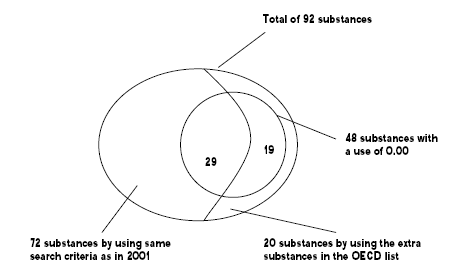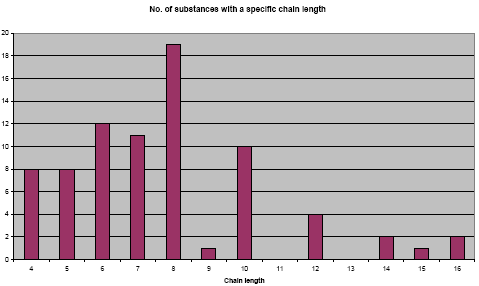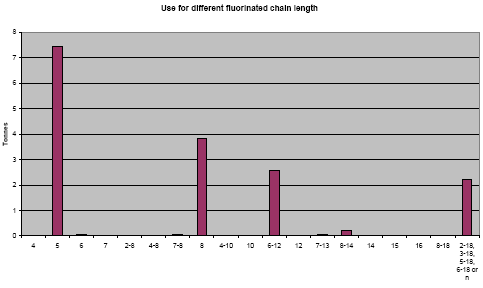Survey and environmental/health assessment of fluorinated substances in impregnated consumer products and impregnating agents
3 Fluorinated substances identified
- 3.1 Contact to companies
- 3.2 Internet search
- 3.3 Information obtained from the Danish Product Register
This chapter contains lists of the specific fluorinated substances identified (by CAS number) in this survey. The contact to companies gave only very little information about uses of specific fluorinated substances. The main sources to fluorinated substances identified are the Internet and the search in the Danish Product Register.
The list of fluorinated substances found by the search in the Danish Product Register and the list of substances found by contact to companies (only one substance) are the only substances that for sure are used in chemicals or in products in Denmark. The list of substances found by searching the Internet are of course used globally, and may be used in chemical products and consumer products in Denmark as well, but it may not necessarily be the case.
3.1 Contact to companies
The substances in Table 3.1 have been identified when contacting different companies in Denmark about the use of fluorinated substances. Strangely enough more information about substances not used in Denmark than substances used in Denmark, was received when interviewing companies. However, when one company informs that they know of a use of fluorinated substances in products not sold in Denmark, it does not exclude that other companies may use the same substances in products in Denmark.
Table 3.1: Fluorinated substances identified by searching the Internet or contacting Danish companies
| CAS No. | Substance name | OECD class | Chain length | Found in |
| 65530-65-6 | Poly(difluoromethylene), a-fluoro-w-[2-[(1-oxooctadecyl)oxy]ethyl]- (TSCA, NDSL) | Fluoro ester compounds (F5) | n | One sealer product for cars (auto polish) in a concentration between 0.085-0.45% |
| 203743-03-7 | Poly(hexadecyl methacrylate/2-hydroxyethyl methacrylate/octadecyl methacrylate)/gamma-omega-perfluoro-C10-C16-alkyl acrylate. | Not on the OECD list | 10-16 | Textile impregnation spray for car interiors in a concentration of about 0.01 mg/kg (uncertain concentration). |
| 9002-84-0 | PFTE-wax | Not on the OECD list | n | Used in printing inks to protect the surface and make the surface smoother |
| 65530-85-0 | Polytetrafluoroethane (Teflon wax) | Not on OECD’s 2006 or 2007 list, but on a former OECD list and identified in the Product Register. | n | Used in paint to form a water repellent film, but not used in products sold in Denmark. Typical content is about 11-18%. |
| 355-49-7 | Perfluorohexadecane (C16F34) | Not on the OECD list | 16 | Used in ski wax (produced in Norway). Questionable if used in Denmark. |
3.2 Internet search
The web-pages of the producers of fluorinated substances have been examined closely in order to learn more about the specific fluorinated substances used. It was only possible to find specific information for DuPont fluorinated products.
When searching the DuPont website it is possible to find MSDS’s of their Zonyl, Foraperle and Forafac products, where some of the fluorinated compounds are listed. However, it is only possible to find the information about the specific substances, if the search is performed on German MSDS’s.
In total, 93 Zonyl, 14 Foraperle and 10 Forafac product MSDS’s exist in German language (September 2007). Table 3.2 below contains a listof the fluorinated compounds used in chemical products from DuPont.
Table 3.2: List of fluorinated substances identified in DuPont fluorinated chemical products. The information is found on the DuPont webpage[11]. Both the chemical name mentioned in the MSDS and used by OECD are listed.
3.3 Information obtained from the Danish Product Register
A search in the Danish Product Register has been performed during the summer of 2007 in order to map the use of fluorinated compounds in products in Denmark. The search represents figures updated in 2007 – the figures thereby represent 2006 volumes.
Only substances and chemical products used occupationally and containing substances classified as dangerous in a concentration of at least 0.1% or 1% (depending on the classification of the substance) have to be registered in the Danish Product Register. As none of the fluorinated compounds are classified as dangerous themselves, the registration will only occur, if they are constituents of products, which are labelled and classified as dangerous of other reasons. In other words, the Danish Product Register does not register all products containing fluorinated compounds on the Danish market, and the registered amounts do not give a complete picture of the total sales in Denmark. The amounts registered are for occupational use, but the chemical products may later on be used for production of consumer articles. Finally, imported finished consumer articles, such as carpets containing fluorinated compounds are not registered in the Product Register. However, the search can be used as a starting point for the following market survey.
In order to be able to compare with the former 2001-search in the Danish Product Register on PFOS and PFOS-related compounds, a search was first made by using the same about 200 substances already used in the search in 2001. This search was supplemented by a search using the OECD preliminary list of PFOS, PFAS, PFOA and related compounds and chemicals that may degrade to PFCA (OECD, 2006) with about 1,000 substances (CAS numbers from the first search was removed).
Most substances on the Danish 2001-list are also on the OECD list, but a few substances was found only on the list used in the 2001 survey. By performing a search using both lists it is possible to compare the new with the former search in the Danish Product Register.
Since the search in the Danish Product Register was carried out for this project, the OECD has updated their list, and now named it: “Lists of PFOS, PFAS, PFOA, PFCA, related compounds and chemicals that may degrade to PFCA” (OECD, 2007). The comparison of these two OECD lists has not been included in this project.
3.3.1 Search in the Danish Product Register
The search in the Danish Product Register resulted in a total of 92 different fluorinated substances. Only 72 of the substances were identified searching the same approximately 200 CAS numbers from the 2001 survey. The other 20 fluorinated substances were identified by using the large OECD list of substances, where the overlaps between the first and the second list were removed in advance.
For 48 of the 72 substances an annual use 0.00 tons was registered. That means that the companies have reported a use of the substances, but have failed to report any amount. The result of the search is illustrated in Figure 3.1.
Figure 3.1: Result of the search in the Danish Product Register

3.3.2 Fluorinated substances identified in the Danish Product Register
The fluorinated substances identified by the search in the Danish Product Register are listed in Table 3.3 below. The substances with the highest use are listed first in the table. For confidentiality reasons no exact amounts are given, but the amounts are instead listed as uses over 5 tonnes in total, below 1 tonnes, below 0.1 tonnes and as 0.00/0.000 i.e. indicating that no amount have been reported to the Danish Product Register. In total, the 44 fluorinated substances registered with an amount, account for an import of 16.5 tonnes in 2006.
These data from the Danish Product Register includes all reported uses of the fluorinated substances, including industrial uses, which may not be consumer relevant. However, it is not possible with the received data to perform an exact calculation of how large a part of the amount that is assumed to be used in consumer products only. Since the products are classified as dangerous it is likely that more are for industrial uses. However, the products for industrial uses may end up as components in consumer products.
Table 3.3: Fluorinated substances identified by the search in the Danish Product Register
3.3.3 The identified substances and their uses
The most important use areas (according to the reported totals) are releasing agents, paint and lacquers, glue, surface active substances and galvano-technical products, which accounts for about 15 of the 16.5 tonnes in total.
The use areas polish and care products, impregnating agents, cleaning agents and surface active substances (non-metal, e.g. for paper and cardboard) accounts for about 0.5 tonnes (of the last 1.5 tonnes). The amounts used in these areas are most likely much higher, as only chemical products labelled as dangerous have to be registered in the Danish Product Register.
In other words, the Danish Product Register does not register all products containing fluorinated compounds on the Danish market, and the registered amounts do not give an adequate picture of the total sales in Denmark. Finally, imported finished products such as raincoats containing fluorinated compounds are not registered in the Product Register.
All identified substances in the Danish Product Register are associated to a specific use area. Figure 3.2 below illustrates the total uses and total amounts of all registered fluorinated compounds within the different use areas. As the total imported amounts only have been registered for about half of the substances, the distribution between the different areas is therefore not necessarily correct, as many numbers are missing. However, for every import registration, which is notified to the Product Register, a use area must be associated. The use areas therefore represent the different uses for the registered fluorinated compounds.
It is difficult to say which uses are only consumer related and which are not. However, it is assumed that hydraulic fluids and lubricants are the only uses, which are not consumer related, and these uses constitute a very small part of the total registered use. It can be discussed whether releasing agents will be a part of consumer products. Releasing agents are compounds used e.g. in moulds in order to get the moulded plastic product for example to release easily from the mould. However, releasing agents can also be used on e.g. frying pans to ensure a non-stick surface.
Figure 3.2: Use of fluorinated substances within different use areas
3.3.4 The identified substances and their OECD grouping
We have appointed all the fluorinated substances a grouping corresponding to the grouping used by OECD as presented in the beginning of this chapter. A few substances have a grouping of “none”, which means that these substances are not on the OECD list, but are on the Danish list from 2001. For these substances the grouping used in this project has been added. The grouping of the substances can be found in the table above, but is also presented in the Figure 3.3 below.
Figure 3.3: The fluorinated substances found in the Danish Product Register grouped in the different OECD categories.
Figure 3.3 shows that 10 of 92 (11%) substances are PFOS related, 3 substances (3%) are PFOS/PFAS[12] related, 29 substances (32%) are PFAS substances, 1 substance (1%) is PFOA, and a large part (42 substances or 46%) are substances that potentially can degrade to perfluorocarboxylic acids, PFCA. The rest of the substances (8 or 9%) are substances that are not listed on the OECD preliminary list of PFOS, PFAS, PFOA and related compounds and chemicals that may degrade to PFCA.
The total use in 2006 of these 44 identified fluorinated substances was 16.5 tonnes. The total amount of fluorinated substances could be much higher, if there had been consumption data of the other 48 substances without registered amounts. For the 16.5 tonnes, which have been reported, the amounts are distributed between the different OECD categories as illustrated in the Figure 3.4 below.
Figure 3.4: Use of fluorinated substances distributed between different OECD fluor categories.
The figure shows that about 2 tonnes of the registered fluorinated substances still are PFOS substances. The category “No OECD category” accounts for almost half of the total registered amount of 16.5 tonnes.
3.3.4.1 Chain length of the identified substances
We have looked at the chain length of the identified substances as the chain length is important with respect to the health and environmental effects of the substances.
The variation of the chain length for the 92 different identified fluorinated substances are illustrated in the figure below. Some of the CAS numbers (21) do not specify a specific chain length, but a range in stead – for example a chain length of 4-8 or 6-18. For these substances the middle equal number has been used as a chain length. Some substances are polymers. For these substances the chain length of the monomer has been used for the calculations. Furthermore, some CAS numbers (13) are listed with a chain length of “n” indicating that the chain length could be almost any large number. These substances have been omitted from the calculations. The table can therefore only be used as an indication of the chain length of the substances registered.
Figure 3.5: Illustration of the distribution of chain length for the different fluorinated substances.

As illustrated in Figure 3.5 above most of the identified fluorinated substances have a chain length between 4 and 10, and the average is just below 8.
When dividing the use of the identified fluorinated substances on their chain length, it can be seen that the main part of the identified fluorinated substances has a chain length of eight or lower (see Figure 3.6).
Figure 3.6: Illustration of the distribution of the use of fluorinated substances for different chain lengths.

3.3.5 Comparison with the former search in 2001
It is not possible directly to compare the 2001-search in the Danish Product Register (Havelund, 2002) directly with the search performed in this project. The 2001-search was only carried out for 175 identified PFOS and PFOS-related compounds on the OECD list at that time. The search in this project has been much broader (about 1,000 PFAS, PFOS, PFOA and substances that can be degraded to PFCAs).
In comparison, 72 fluorinated substances were found in this 2007 search in the Danish Product register, when looking at the same search group from 2001. 20 additional fluorinated compounds have been identified by using the OECD list from 2006 in this 2007-search.
In comparison the amounts of fluorinated compounds used in Denmark seem to have decreased from 2001 to 2007. An amount of 16 tonnes were the result of the both the 2001 search and the 2007 search. However, if the use registered for the 20 “new” substances is subtracted, the registered amount in the 2007-search is 9 tonnes for the same search group of substances as in the 2001-search. This is in line with the decreased use of PFOS precursors since 2001. However, it is important to notice that the amounts in the Product Register most probably only account for a smaller part of the total amount used in Denmark. It is not known whether the use of fluorinated compounds in products not classified as dangerous, and thereby not registered in the Danish Product Register, has increased.
When comparing the substances found in the 2001 search with this search in 2007 in the Product Register, it can be seen that 48 chemicals of the 75 (2001) and 72 (2007), respectively, are exactly the same substances. In other words 27 fluorinated substances identified in the 2001 search are no longer used. Groups of fluorinated compounds (OECD grouping of 2001), where most of the substances are no longer in use are:
- Perfluoroalkylsulfonyl derivates
- Perfluoroalkylsulfonamide aminopropyl derivates
- Perfluoroalkylsulfonamide chrom complex derivates
When comparing the substances found in the 2001 search with this search, it is striking that many (14) of the repeaters – substances registered both in 2001 and in 2007 are used within galvano-technical products.
It is not possible to say whether the use decrease from 2001 until today is the evidence of a total decrease of the use of fluorinated substances or just a shift from PFOS and PFOS-related substances to fluorotelomers. It may, however, be a logical explanation as production of these chemicals has ceased and use is forbidden by summer 2008.
Fodnoter
[11] http://msds.dupont.com/NASApp/msds/Mediator
[12] In the OECD report PFAS is defined as perfluoroalkyl sulfonates, i.e. sulfonic acids with a chain length other than 8 for PFOS (OECD, 2006).
Version 1.0 October 2008, © Danish Environmental Protection Agency